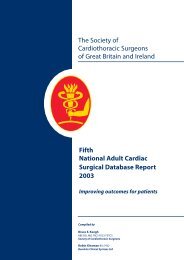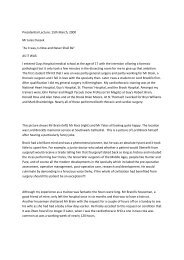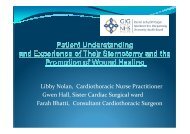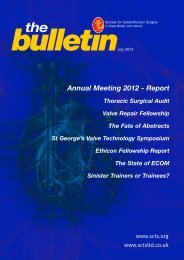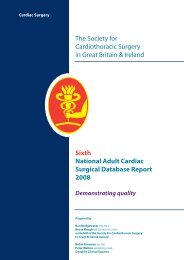A guide to commissioning cardiac surgical services - NHS ...
A guide to commissioning cardiac surgical services - NHS ...
A guide to commissioning cardiac surgical services - NHS ...
Create successful ePaper yourself
Turn your PDF publications into a flip-book with our unique Google optimized e-Paper software.
A <strong>guide</strong> <strong>to</strong> <strong>commissioning</strong> <strong>cardiac</strong> <strong>surgical</strong> <strong>services</strong><br />
Discharge planning<br />
Managing and maintaining patient<br />
flow within the acute setting requires<br />
a focus on discharge whilst<br />
maintaining an approach that is<br />
focussed on the individuals discharge<br />
needs. Assessing the patients<br />
discharge needs pre operatively,<br />
educating patient and family about<br />
recovery at home and informing<br />
them about care they receive once<br />
discharged is important <strong>to</strong> include<br />
within the pre operative assessment<br />
clinic service. Optimising the patients<br />
discharge can help improve the<br />
patients’ experience, reduce the<br />
overall inpatients length of stay;<br />
improve patient flow and efficiency in<br />
use of beds.<br />
Delayed discharges are a frustration<br />
for patients and staff alike.<br />
Establishing the cause of delay and<br />
how <strong>to</strong> overcome issues preventing<br />
discharge is important <strong>to</strong> understand<br />
and recognises the need for<br />
collaborative working across the<br />
health professions if you are <strong>to</strong><br />
improve patient experience and<br />
patient flow. An important part of<br />
the discharge process is <strong>to</strong> discuss the<br />
possible options before the patients<br />
admission for surgery, encouraging<br />
them <strong>to</strong>gether with their family (if<br />
appropriate) <strong>to</strong> consider their<br />
discharge plans and place of care.<br />
Discharge planning should embrace<br />
physical, psychological and social<br />
aspects of the patients care.<br />
All of the case studies within this<br />
document contain elements of<br />
discharge planning and address the<br />
importance of:<br />
• Securing admission/discharge<br />
pro<strong>to</strong>cols between providers.<br />
• Providing information packs for<br />
patients and carers.<br />
• Establishing intermediate care<br />
processes.<br />
• Seeking the patients and carers<br />
views and involving them in<br />
discussions <strong>to</strong> inform change.<br />
The following two case studies<br />
illustrate an interesting approach <strong>to</strong><br />
discharge planning.<br />
The case study presented by Trent<br />
Cardiac Centre illustrates how<br />
recognising the need for collaborative<br />
working with physiotherapists,<br />
intensive care practitioners, <strong>cardiac</strong><br />
rehabilitation nurses, pharmacists,<br />
medical and anaesthetic staff hugely<br />
improves the process as <strong>to</strong>gether they<br />
were able <strong>to</strong> identify patients suitable<br />
for early discharge home. Their<br />
combined knowledge and expertise<br />
was used <strong>to</strong> jointly assess the patient<br />
pre and post operatively <strong>to</strong> identify<br />
any specific needs or issues <strong>to</strong> be<br />
addressed. The multidisciplinary<br />
team developed a range of decision<br />
support <strong>to</strong>ols <strong>to</strong> complement the<br />
patient assessment process supported<br />
by a series of home visits by the<br />
specialist nursing team.<br />
One mechanism for optimising<br />
discharge planning is <strong>to</strong> improve<br />
ward efficiency by reducing and<br />
eliminating unnecessary avoidable<br />
delays by using visual management<br />
systems (VMS) <strong>to</strong> track patient<br />
progress, trouble-shoot and progress<br />
chase. An example of this approach is<br />
demonstrated within the Papworth<br />
case study. VSMs bring <strong>to</strong>gether the<br />
multidisciplinary team <strong>to</strong> plan<br />
discharge/transfer focussing the team<br />
on the steps required <strong>to</strong> support<br />
timely and safe discharge/transfer.<br />
They help improve the knowledge<br />
among the multidisciplinary team of<br />
the wider health and social care<br />
aspects that impact on the individual<br />
patients discharge and the<br />
requirement for advance planning <strong>to</strong><br />
ensure that <strong>services</strong> and support are<br />
available on discharge.<br />
The case study presented by<br />
Papworth Hospital <strong>NHS</strong> Foundation<br />
Trust outlines how they reduced their<br />
<strong>to</strong>tal inpatients length of stay<br />
through using audit of delayed<br />
discharges <strong>to</strong> reduce variation in post<br />
operative practice and address<br />
patient focussed discharge at pre<br />
operative assessment clinic.<br />
www.improvement.nhs.uk/heart<br />
35



